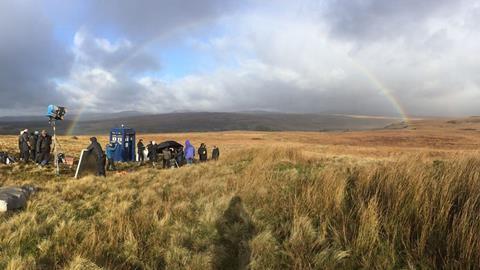No one can really see into the future, of course, but there are experts out there who might just be able to offer us a glimpse of what is to come. End users, analysts and consultants consider what 2018 might bring across TV, cinema and online.
Sinead Greenaway, Chief Technology and Operations Officer, UKTV
2018 will be the year that we start to see a meaningful shift in the distribution elements of our supply chain.
“Traditional playout and media management vendors are finally adopting cloud and IP and, critically, they are starting to design “as a service” offerings that reinvent the old capex-and-divide models.
”New commercial models and service level agreements will begin to emerge and customers such as ourselves are likely to be encouraging and ultimately adopting a much more federated approach to the technology and services that enable us to serve the content our viewers love in a timely and cost-efficient manner.”
Orpheus Warr, Chief Technology Officer, Channel 4
2018 will be the year that we start to use AI for advanced automated metadata extraction from video content.
“This will lead to the opportunity for both improved viewer recommendations and monetisation, and the automated generation at scale of subtitles. At the same time, there are longer-term opportunities to introduce AI into our internal estate and business processes.
”With a rich set of real-time data sources driving better insight, AI can be used to take on much of the heavy lifting in our workflows and operations, freeing people up to focus on the creative aspects of all types of work (not just content) that add real value to our business.

“Imagine: automatic recovery of playout and distribution failures based upon AI, using huge sets of historical data to identify the solution that is fastest and most likely to succeed, and a conversational interface to inform real people of what action is being taken; Automated content review and compliance, not just of technical aspects but legal too; Access service production, driven by improvements in voice recognition but also systems that understand context, identifying not just what is being said but what is being seen; And intelligent selection of contribution and distribution paths based on an innate understanding of content quality, value, risk and cost.
“It may sound like the stuff of science fiction, but the first words I speak every morning are directed at a voice enabled assistant on my kitchen worktop, so I’m willing to believe there is more to come, and soon.”
Ian Brotherston, Chief Executive, TVT
2018 will be the year that IP and cloud broadcast finally come of age.
“In an increasingly globalised marketplace, where fibre, satellite and IP services are converging in linear and on-demand playout, these next 12 months will mark the moment when IP and cloud broadcast finally comes of age.
”In short, IP is ready for primetime. As the entire industry embraces the move towards this new era of all-IP, we will increasingly see the impact of cloud technologies and approaches addressing the complex needs of today’s digitally savvy consumers. In doing so, we can help drive the future of next generation media and entertainment into 2018 and beyond.”
Steve Sharman, Founder, Hackthorn Innovation
2018 will be the year that the media technology skills shortage gets increasingly acute.
“It’s already extremely difficult to recruit good people into media technology roles at all levels, and things are getting worse.

There are a number of things we need to think about quickly: issues of sexism and paternalism that deter very capable women from being interested in careers in media tech; training, skills development, compensation and job satisfaction; getting much closer to universities and schools to boost the recruitment pipeline; and so on.
“We’ve also got to get out into the world as an industry and make sure potential recruits are reminded that we have some interesting challenges, we’re changing fast, and what we do has a big impact on people’s lives.”
Rich Berger, Chief Executive, MovieLabs
2018 will the year that that the cinema industry develops new home viewing experiences.
“This will include the development of new features for the Movies Anywhere (MA) ecosystem. We expect these to include enhanced content and playback experiences and other benefits for movie collectors, as well as new ways to link experiences across platforms and devices.
”2018 will also see broader adoption of standardised packages of bonus content and extras to consumers across multiple new digital platforms, including MA.
”It should be the year that studios begin to include more content experiences that are specifically designed to take advantage of the unique benefits of digital distribution platforms. This will help to increase the value of digital movie ownership.”
Hamish Greig, Technical Director, CTV Outside Broadcasts
2018 will be the year that HDR takes precedence over increased screen resolution, even when enabled with HD.
“The Ultra High Definition (UHD) experience is dictated by screen size and distance from the screen whereas there’s a growing realisation that this increased line resolution has nothing like the subjective impact for viewers that a BT.2020 colour space High Dynamic Range (HDR) picture has.
”It is as much about the detail in the shadows and lowlights as well as the bright highlights and the biggest wow factor comes with enabling HDR and Wide Colour Gamut (WCG), rather than UHD. WCG enhances the range of colours, notably in the primary green area of the spectrum, to improve the quality of the pixels, giving more vibrant and wide ranging colours.
“Despite doubling the storage requirements and transfer bandwidth and requiring the use of 10-bit codecs, productions should be able to leverage this significant uplift in content quality while still being able to enjoy all the standard tools and features available in 1080i SDR (Standard Dynamic Range) facilities.
”To my mind, SDR images look like pictures of a scene, whereas HDR images really look like the scene. On the high street, UHD seems like a convenient marketing ploy to sell more TVs, whereas HDR really feels like the next big step in broadcasting.
”Perhaps 3G-SDI 1080P50 with LOG gamma HDR should be the next generation of TV production, certainly more so than an unnecessarily leap to 12G-SDI for 2160P50 UHD resolution. In my opinion, we should leave 4K for the cinema big screen and instead improve the pixel quality for domestic viewers.”
Adam Poulter, Managing Director, Vubiquity International
2018 will be the year that online video services become more personalised, adding curated aggregation to make them more local and localised.
“Deep, wide and rich libraries made up of predominantly mainstream US and movie centric content are now somewhat vanilla and available on almost every video platform. Think Netflix and Amazon Prime: the B52 bombers of the deep and wide library. Consumers are consequently overwhelmed with so much of the same choice across these platforms that ironically there’s little choice.
”Roll on the evolution of social TV that is driving digital natives to crave flavour in high quality, niche, relatable, age relevant, socially astute, ethnically sensitive, culturally local, language localised, community based ‘me centric’ content. ‘I’ want to surface, explore, share, like and chat about video in a future leaning way where my digital community is local. By its very definition the word ‘community’ infers a location which is adjacent to where I am: and in my digital footprint that’s where my video interests lie.
”So the 2018 video landscape will continue to evolve towards personalised, curated aggregation with preferences for local and localised content (subject to where ‘I’ originate from in the world) married with live and linear offerings, because live and linear gives authenticity to a ‘glocal’ feel. Global media inclusion delivered in my personalised, local feed and supplemented by premium Hollywood blockbusters. Think of it as the next generation of the content king. Long live the King!”
MovieLabs looks to be the industry’s North Star
- 1
- 2
 Currently reading
Currently readingAI to HDR: What to expect from media technology in 2018
- 3
- 4
- 5
- 6
- 7
- 8
- 9
































1 Readers' comment